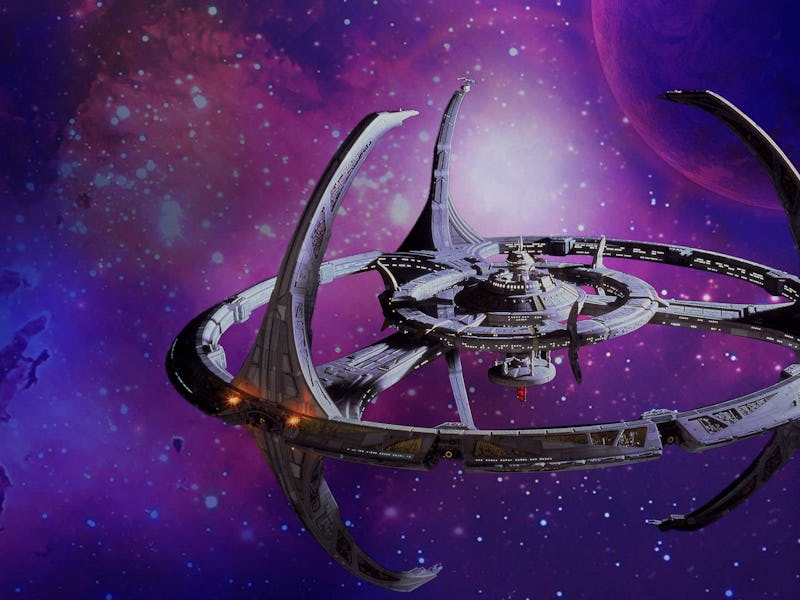Fans Had Barely Gotten to Know the Crew of DS9. Then They Lost Their Minds.
30 years ago, Deep Space Nine took its turn into strange, bold territory.

In science fiction television, you can learn how much your audience loves your characters by getting them to act out of character. Star Trek has a long history of throwing its characters into personality-altering romps, starting in 1966 with the TOS episode “The Naked Time,” and again with the TNG episode in 1987 “The Naked Now.” Having the entire crew lose their minds is such a common trope that Lower Decks parodied it in the 2021 “I, Excretus.” But 30 years ago, Deep Space Nine took its turn into strange, bold territory.
“Dramatis Personae” is not considered one of the great DS9 episodes, and many fans may not remember its significance. The premise involves the station’s crew having their personalities overridden by ancient telepathic imprints from a long-dead species called the Saltah'na. After a Klingon ship explodes near the station, a sole Klingon survivor beams and accidentally spreads the telepathic virus. But instead of picking up a nasty disease or a DNA-altering weapon, our heroes get roles and moods.
O’Brien and Kira plotting in “Dramatis Personae.”
Star Trek floated something similar in the TOS episode “Return to Tomorrow,” but in that episode, the crew knew what they were doing and purposefully took the risk. And in the TNG episode “Power Play,” Troi, O’Brien, and Data were possessed by ancient alien souls, but that was made clear early, and the rest of the crew was unaffected.
What “Dramatis Personae” did was way weider. Halfway through the episode, the audience still has no idea why the entire crew is acting bonkers, and most of the action plays out like a simmering mutiny. The first episode, “Emissary,” established tensions between the Bajorians who own the station and the Federation crew that help run it, and 18 episodes later, it looked like that uneasy alliance would boil over into a full-on battle. All the main characters turn into sneaky conspirators, trying to slyly figure out who’s on the side of Major Kira, and who will side with Commander Sisko. It feels like every character suddenly acts like they’re on a pirate ship or from the Mirror Universe.
Avery Brooks and Nana Visitor completely commit to the silliness.
Tensions run high, but the brilliant and unique twist is that what appears to be an episode about a civil war turns into a detective story. Because he’s a shapeshifter, Odo’s non-humanoid brain wasn’t affected by the Saltah’na’s telepathic signals. Only he can figure out what’s going on, but he’s in the dark like the audience, and it takes him more than half the episode to solve the mystery. It’s late in the game when Odo floats the possible explanation for everyone acting so violent and untrusting: the ancient conflict that destroyed the Saltah’na is playing out again, but with contemporary conflicts among the DS9 crew used to sow hatred and mistrust. Prejudices literally take on new forms.
All of this makes “Dramatis Personae” a fun, self-contained sci-fi story with a Twilight Zone-esque twist, but in the Trek tradition. However, for Deep Space Nine as a series, what this episode demonstrated was much more interesting.
Odo is on the case.
Because only René Auberjonois is acting like his usual character, we got to see just how good the DS9 cast really was. From Avery Brooks playing Commander Sisko with an unhinged intensity, to Nana Visitor turning Major Kira into a ruthless mutineer, to Colm Meaney suggesting that Chief O’Brien might be a secret bigot, the actors played their regular characters convincingly, but through a cracked lens. This didn’t mean these bizzaro versions were straight-up evil, or chewing the scenery like Mirror Universe duplicates. Instead, because the other characters don’t immediately notice the changes, their slide into paranoia and cruelty is gradual.
The cast of Deep Space Nine proved they could play a wide range of emotions and points of view. As DS9 progressed, it became known for its hard-hitting political allegories and ambitious serialization, but its true brilliance was in its subtle characterizations. The people who lived on this station were multifaceted. And in this quiet, strange episode, made when these characters were still new, DS9 showed just what they — and their actors — were capable of.
Star Trek: Deep Space Nine streams on Paramount+.
This article was originally published on